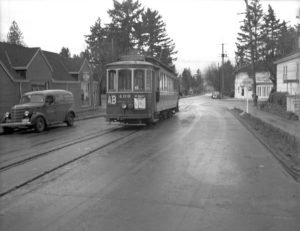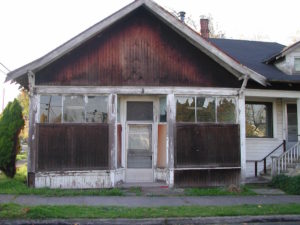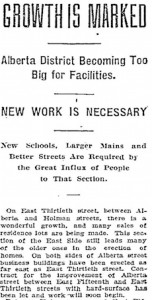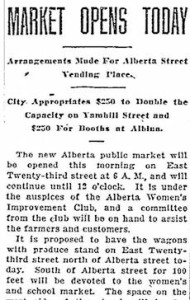By Doug Decker, Historian
Development of the streetcar line changed everything about the landscape that eventually became our neighborhood. It takes lots of imagination to conjure up a picture of what our neighborhood might have looked like 100 years ago. The fields and forests of today’s Alberta district, Vernon, and Concordia were way out in the country, beyond the far edge of Portland. But one key development changed all that: the Alberta Streetcar.

First constructed in 1903, the line left downtown at SW 2nd and Alder, crossed the old Steel Bridge and ran north up Union (today’s Martin Luther King Jr. Blvd.), where it turned east on Alberta to NE 25th. A few years later it was extended five blocks east on Alberta to NE 30th, and then a few years later north on NE 30th to Ainsworth, which became the end of the line.
Wherever the streetcar went, so did development. Initially just two rails in the mud through brush and open fields, by the heyday of Portland’s streetcars in the teens and 1920s, the Alberta streetcar had attracted scores of business owners and thousands of residents to this new developing part of the city. Its impact on the shape and feel of the neighborhood can’t be overstated.
The December 28, 1913 edition of The Oregonian reported: “The streetcars are now operated to East Thirtieth street and Ainsworth avenue. The line runs double cars in order to take care of the traffic and even then the cars morning and evening are overcrowded.”
The fact that autos were not the primary mode of transport in those days meant streetcars—and lots of foot traffic—fueled growth of the business district along Alberta. It was a thriving place of activity and commerce, not unlike today. But by the 1940s, with automobiles dominating the transportation picture and Union Avenue no longer the main north-south travel corridor (travel had shifted to Interstate Avenue), the Alberta streetcar became disused and was eventually replaced by a bus. By then, Portland had turned its back on its once robust streetcar system. The last day for the line was August 1, 1948.
As if to silence the era of the Alberta streetcar once and for all, in September 1949 The Oregonian reported that the City of Portland authorized a $75,000 paving contract that took 11 days to erase all evidence of the tracks:
“A total of 110,748 yards of materials went into the project to bury the old Alberta streetcar tracks. Paving tonnage amounted to 8,407 tons of blacktop.”
Today, there aren’t many specific clues other than the hundreds of streetcar-era buildings that would not have developed without the line. When you’re out for a walk along our neighborhood’s path of the old streetcar line (1.8 miles along Alberta between MLK and 30th; then 30th Avenue between Alberta and Ainsworth), see what evidence you can find.
Check out Northeast Portland neighborhood historian Doug Decker’s blog www.alamedahistory.org for more on local lore, including the history of the nearby Broadway Streetcar line.
ASK the Historian: Have a history question that needs to be solved? Drop us a note and we’ll put Doug Decker on it. Email CNewsEditor@ConcordiaPDX.org.


